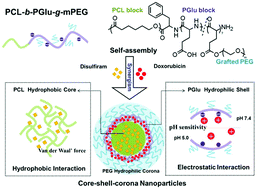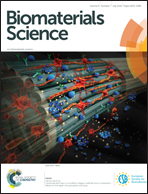Synergistic breast tumor cell killing achieved by intracellular co-delivery of doxorubicin and disulfiram via core–shell–corona nanoparticles†
Abstract
Combination therapy with different functional chemotherapeutic agents based on nano-drug delivery systems is an effective strategy for the treatment of breast cancer. However, co-delivery of drug molecules with different physicochemical properties still remains a challenge. In this study, an amphiphilic poly (ε-caprolactone)-b-poly (L-glutamic acid)-g-methoxy poly (ethylene glycol) (PCL-b-PGlu-g-mPEG) copolymer was designed and synthesized to develop a nanocarrier for the co-delivery of hydrophilic doxorubicin (DOX) and hydrophobic disulfiram (DSF). The amphiphilic copolymer self-assembled into core–shell–corona structured nanoparticles with the hydrophobic PCL core for DSF loading (hydrophobic interaction) and anionic poly (glutamic acid) shell for DOX loading (electrostatic interaction). DSF and DOX co-loaded nanoparticles (Co-NPs) resulted in high drug loading and precisely controlled DSF/DOX ratio via formulation optimization. Compared with free drug solutions, DSF and DOX delivered by the Co-NPs were found to have improved intracellular accumulation. Results of cytotoxicity assays showed that DSF/DOX delivered at the weight ratio of 0.5 and 1 could achieve a synergistic cytotoxic effect on breast cancer cell lines (MCF-7 and MDA-MB-231). In vivo imaging confirmed that the core–shell–corona nanoparticles could efficiently accumulate in tumors. In vivo anti-tumor effect results indicated that Co-NPs showed an improved drug synergistic effect on antitumor activity compared with the free drug combination. Therefore, it can be concluded that core–shell–corona nanoparticles prepared by PCL-b-PGlu-g-mPEG could be a promising co-delivery system for drug combination therapy in the treatment of breast cancer.



 Please wait while we load your content...
Please wait while we load your content...